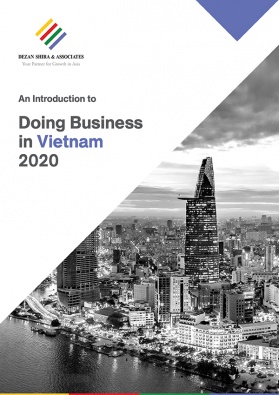How to Operate Your Vietnam Business Remotely During COVID-19
By Adam Livermore, Thomas Zhang, and Chris Devonshire-Ellis
The COVID-19 outbreak has triggered the world’s largest ever work-from-home experiment as businesses are called to consider how to effectively utilize their employees while also minimizing physical contact.
That issue has now begun to impact businesses across the world, where the infectious nature of the outbreak means the avoidance of gathering in public, which includes staff working in offices or traveling to the workplace using public transit, in addition to the banning of other public gatherings.
The situation remains challenging, with staff working from home and businesses disrupted. It also appears the situation will remain with the global business community for a while. So how can businesses across North America, Europe, South America, Africa, the Middle East, and Asia manage not just their own reductions in office and factory workforce, but also manage their Vietnam subsidiary operations as well?
Under these circumstances, most options for the standard operation of businesses using traditional methodologies are temporarily unavailable. Managers at foreign-invested entities (FIEs) in Vietnam have had to move very quickly to pick up the slack. This has meant the establishment of new workflows that mitigate staff travel while also ensuring that work timelines are met. The way employees collaborate remotely has had to be re-assessed.
In this article, we look at the methodology and technical solutions when operating a business that is under lockdown or needs to start preparing for the eventuality.
Appoint and empower a Chief Information Officer
Businesses need to appoint a responsible person to act as a Chief Information Officer (CIO). This can be a high-stress role as the CIO has responsibility for the infrastructure on which the remote office heavily relies, the smooth sharing of information across the organization, and the security of that information.
It is vital that a CIO is able to coordinate with all staff, be aware of their location and situation, and is able to accurately disseminate company information, instructions, and assistance where required.
Enforcing the security and efficiency of your corporate IT assets
Foremost in the mind of the CIO at such a time should be the security of confidential corporate information.
Employees are working from home.
- Can they rely on the existing corporate infrastructure in place to do their jobs?
- Is their organization reliant on centralized, physical servers located in server rooms at HQ or in data centers?
If so, are your employees at home and in Vietnam able to access those servers sufficiently quickly to do their work under current circumstances?
If the company does not put in place an explicit short-term policy and take necessary measures to allow employees to do their work and meet deadlines, the inevitable consequence is that those employees will start to fall back on “non-corporate” channels of information exchange.
In Vietnam, this generally will mean apps like Zalo, Facebook messenger, Whatsapp, Viber, and WeChat.
The dangers of pushing corporate content through such channels hardly needs explaining here. Companies should do all that they can to look for viable alternatives as speedily as possible.
Options fall into two general categories – improving access to existing corporate information hubs, and promptly creating new corporate channels for information exchange that don’t rely on the existing infrastructure.
The first line of thinking assumes that much of the critical corporate information and tools utilized by employees resides on physical infrastructure, rather than in “the cloud” on platforms like Microsoft Azure or Office365. The migration of this data is not feasible in the short-term, so the best option to facilitate access to this information is to improve both the speed and the security of connecting to that data by employees working in a non-office environment.
Access via Remote Desktop Protocol (RDP) – which encrypts data in transmission – can be considered for systems that are not browser-based, and which do not restrict access to office environments. For those systems that are normally restricted to office-based access, the company will need to consider putting in place VPN connections between each employee’s computer and a cap-stone server that can link to the relevant corporate server.
Only very limited destination sources should be enabled for the VPN, to minimize the system’s exposure to the internet and thereby reduce the security risk when employees connect with a wider range of non-corporate resources.
Computers operating in such remote environments should be protected by tools, including anti-virus software, as such laptops are no longer inside the security perimeter of your office environment. The anti-virus software installed in your office might not even be updated promptly when laptops are outside of the office, as certain kinds of deployments would only allow updates from internal resources.
BitLocker is another tool that should be considered, as the possibility of a laptop being lost or stolen increases rapidly when lots of staff work remotely. BitLocker adds an extra level of access security by encrypting information residing on the local hard disk of the computer.
We can assume that access speed will be negatively affected due to employees working outside of the normal corporate environment, because internet speeds can be expected to be lower. However, accessing internet via a 4G hotspot can alleviate the issue.
Popular cloud and hybrid cloud-based solutions
Another option available to companies is to look at immediately available alternatives to reduce their over-reliance on corporate infrastructure, which can be difficult for other remotely based staff to access from their homes. The most popular options, at present, have been Microsoft Office365. Other options, such as Slack have also seen a big surge in popularity.
What these services do is provide a set of corporate communication and collaboration tools that directly links to the company’s global directory but that does not rely on data sitting within physical company servers. These cloud-based solutions can easily be accessed anywhere and at anytime.
Take Office365 as an example, this platform provides a wide range of functionalities to support remote working as a byproduct of its overall design. SharePoint Online (SPO) is a cloud-based tool to store and control corporate information, which can be utilized across many other applications.
Microsoft Teams is a communication and collaboration tool that synchronizes with SPO to deliver a wide range of functionality to users. Teams provides a stable option for conference calling between colleagues based both inside and outside of Vietnam. Other tools, such as Flow (now renamed as PowerAutomation) allow companies to quickly re-organize and streamline their business processes to meet the challenges of remote-based employees.
More importantly, Office365 enables the company to manage different aspects of their business on one universal platform – email, file sharing and access, and collaboration – are all integrated within the same platform and delivered with a high degree of reliability and security. This platform also guarantees that all the information it contains is controlled under the company’s own security policies and requirements. This is one big advantage for compliance, both, under local laws and regulations and to contractual commitments to clients.
Challenging the traditional work model – tap into new growth areas
The options mentioned above represent fire-fighting plans for the short-term that can get your employees functioning efficiently again. However, with intelligent planning and implementation, they can also form part of the base for your long-term, cloud, or hybrid cloud IT infrastructure.
While the COVID-19 outbreak poses a short-term challenge for businesses, in the medium- to long-term it may actually provide the catalyst for companies to adopt the remote working concept, supplemented by the wide range of technology tools already available to increase worker efficiency. Indeed, it may herald the final nail in the coffin for the “traditional industries” – bricks and mortar retail, the leasing of physical office environments, and even offline consumer banking.
If you are a CIO at an MNC, opportunities exist for you as well. Vietnam can potentially become your “petri dish” for experimentation with appropriate cloud-based tools suitable for remote working, which (if successful) can later be more easily applied to more change-resistant sectors of your organization outside of Vietnam.
Last year, Vietnam’s Viettel and Mobiphone received trial licenses to pilot 5G service in the country. The operators plan to launch commercial service sometime in 2020. This is going to further accelerate the adoption of digital tools and platforms that enable remote working in a secure environment.
About Us
Vietnam Briefing is produced by Dezan Shira & Associates. The firm assists foreign investors throughout Asia from offices across the world, including in Hanoi and Ho Chi Minh City. Readers may write to vietnam@dezshira.com for more support on doing business in Vietnam.
- Previous Article COVID-19 in Vietnam: Reisebestimmungen
- Next Article Vietnam to Increase Labor Related Administrative Violation Fines







